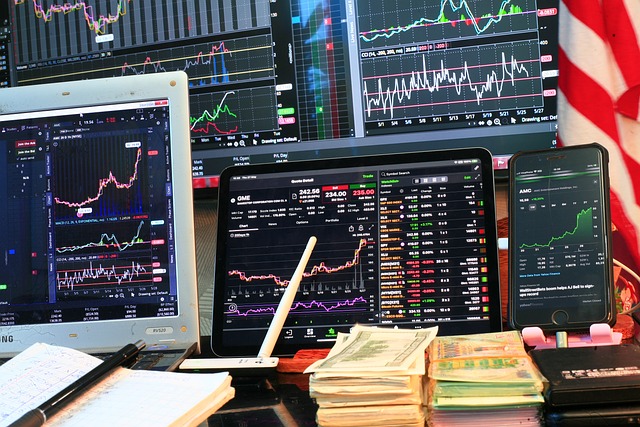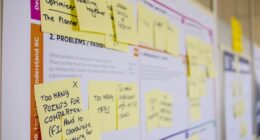Econometrics applies statistical methods to economic data for causal analysis, while statistics focuses on data analysis and inference more broadly.
What is Econometrics?

Econometrics, as defined in the article, is the application of statistical methods to economic data to analyze and quantify economic relationships. It involves the use of mathematical models and statistical techniques to understand and predict economic phenomena. The objectives of econometrics include estimating economic relationships, testing economic theories, and making predictions for policy decisions. Econometrics finds application in various areas such as finance, labor economics, and macroeconomics.
1. Defining Econometrics
Econometrics is a discipline that combines economic theory and statistical analysis to provide insights into economic phenomena. It applies mathematical and statistical techniques to real-world data, aiming to understand and quantify economic relationships.
This field is instrumental in developing economic theories, forecasting economic variables, and evaluating economic policies. By studying econometrics, economists gain valuable insights into how the economy works. Defining econometrics involves highlighting its focus on empirical analysis.
Econometricians rely on real-world data to estimate and test economic models, enabling them to draw meaningful conclusions about the functioning of the economy. This distinguishes econometrics from purely theoretical approaches in economics.
The objectives of econometrics include developing and improving economic theories, forecasting economic variables, and evaluating the impact of economic policies. Through the use of statistical tools and techniques, econometricians are able to estimate the relationships between economic variables and provide evidence-based insights.
Application areas of econometrics encompass macroeconomics, microeconomics, finance, and labor economics. It finds wide application in policy analysis, market research, and academic research.
Moreover, econometrics plays a crucial role in shaping economic policy decisions, understanding consumer behavior, and providing insights into the functioning of financial markets.
Familiarity with the definition and importance of econometrics enhances our understanding of economics and equips economists with a powerful toolkit for analyzing and interpreting economic data. It becomes an indispensable tool for comprehending and predicting economic phenomena.
2. Objectives of Econometrics
The objectives of econometrics are to estimate economic relationships, test economic theories, and make predictions or forecasts. These objectives are achieved through the use of statistical methods and techniques.
1. Estimate economic relationships: One of the main objectives of econometrics is to estimate the relationships between different economic variables. This involves using statistical models to quantify the relationship between variables such as income and consumption, interest rates and investment, or wages and employment. By estimating these relationships, economists can gain insights into how changes in one variable affect another.
2. Test economic theories: Econometrics is also used to test economic theories and hypotheses. By collecting and analyzing data, economists can evaluate the validity of economic theories and determine whether they hold true in the real world. This involves using statistical techniques to measure the strength of the relationship between variables and to determine the statistical significance of the results.
3. Make predictions or forecasts: Another objective of econometrics is to make predictions or forecasts about future economic trends or outcomes. By analyzing historical data and identifying patterns or relationships, economists can develop models that can be used to predict future economic conditions. These predictions can be helpful for policymakers, businesses, and individuals in making informed decisions.
The objectives of econometrics are to estimate economic relationships, test economic theories, and make predictions or forecasts. These objectives are achieved through the use of statistical methods and techniques, and they play a crucial role in understanding and analyzing economic phenomena.
3. Application Areas of Econometrics
Here is a table showcasing the application areas of econometrics:
| Application Areas of Econometrics |
|---|
| Economic Forecasting |
| Policy Evaluation |
| Financial Econometrics |
| Health Economics |
| Labor Economics |
| Environmental Economics |
| International Trade and Development |
| Marketing Research |
Econometrics is widely used in various fields to analyze economic data and make informed decisions. Economic forecasting utilizes econometric models to predict future economic trends.
Policy evaluation assesses the impact and effectiveness of governmental policies. Financial econometrics applies econometric techniques to financial markets and investments. Health economics employs econometric methods to study the relationship between healthcare services and outcomes.
Labor economics analyzes the labor market and labor-related issues using econometric tools. Environmental economics investigates the economic impact of environmental policies and analyzes the relationship between the economy and the environment.
International trade and development examines the effects of international trade and global development using econometric models. Marketing research employs econometric techniques to analyze consumer behavior and market trends. By analyzing data and employing statistical techniques, econometrics contributes to decision-making processes in these Application Areas of Econometrics.
What is Statistics?

On the other hand, statistics, as highlighted in the article, is the collection, analysis, interpretation, presentation, and organization of data. It involves the use of mathematical procedures and techniques to summarize and analyze data sets. Statistics aims to provide insights and draw conclusions from data, enabling informed decision-making. It finds application in fields such as science, healthcare, social sciences, and business.
1. Defining Statistics
Statistics is the field of study that focuses on collecting, organizing, analyzing, interpreting, and presenting data. It involves the application of mathematical principles and techniques to analyze and understand numerical information. When defining statistics, it refers to the methods used to collect, analyze, and interpret data to make informed decisions and draw meaningful conclusions. Statistics encompasses various aspects such as data collection, data representation, data analysis, and inference.
The objectives of statistics are to provide a systematic approach to data analysis, uncover patterns and relationships in data, quantify uncertainty, make predictions, and support decision-making processes. Its aim is to provide reliable and objective information based on empirical evidence. The application areas of statistics are vast and diverse. It is used in various fields such as business and economics, social sciences, healthcare, environmental studies, and scientific research, among others. Statistics is applied to explore questions, test hypotheses, make predictions, and guide policy-making processes.
Ultimately, statistics plays a crucial role in understanding and interpreting data, enabling us to make meaningful interpretations and informed decisions. It provides a framework for analyzing empirical evidence and helps us to draw reliable conclusions and make predictions based on data.
2. Objectives of Statistics
- The objectives of statistics are to provide a framework for data analysis and interpretation.
- The objectives of statistics are to summarize and describe data, allowing for a better understanding of patterns and trends.
- The objectives of statistics are to make inferences and draw conclusions from data, enabling decision-making processes.
- The objectives of statistics are to quantify uncertainty and measure the reliability of results through inferential statistics.
- The objectives of statistics are to test hypotheses and make predictions using statistical models and techniques.
- The objectives of statistics are to identify relationships and associations between variables, aiding in the exploration of cause and effect.
- The objectives of statistics are to assess the impact of various factors on a particular phenomenon or outcome.
- The objectives of statistics are to provide a basis for the design and implementation of experiments and surveys.
- The objectives of statistics are to provide a means for comparison and benchmarking across different groups or populations.
- The objectives of statistics are to contribute to the development of theories and knowledge in various domains of study.
3. Application Areas of Statistics
| Economics | Business | Finance |
| Healthcare | Social Sciences | Market Research |
| Environmental Science | Education | Public Policy |
In the field of statistics, there are various application areas where statistical techniques are utilized. These application areas of statistics include economics, business, finance, healthcare, social sciences, market research, environmental science, education, and public policy.
In economics, statistics are used to analyze and interpret economic data, such as GDP, inflation rates, and unemployment rates, to make informed decisions and predictions about the economy.
Businesses rely on statistics to analyze market trends, consumer behavior, and sales data to develop effective marketing strategies and make data-driven decisions.
In the financial sector, statistics play a crucial role in risk analysis, portfolio management, and investment decision-making.
Healthcare professionals use statistical analysis to study disease patterns, evaluate treatment outcomes, and conduct clinical trials to improve patient care.
Statistics are also widely used in social sciences, such as sociology and psychology, to analyze survey data, conduct experiments, and draw conclusions about human behavior.
Market research relies on statistical techniques to collect, analyze, and interpret data on consumer preferences, market trends, and product demand.
Environmental scientists use statistics to study climate change, analyze environmental data, and make predictions about future environmental conditions.
In the field of education, statistics help in conducting educational research, evaluating educational programs, and assessing student performance.
Statistics play a crucial role in shaping public policy by providing policymakers with reliable data and evidence to inform decision-making processes.
Statistics have a wide range of application areas and are essential in various fields to analyze data, make predictions, and inform decision-making processes.
Key Differences Between Econometrics and Statistics
The key differences between econometrics and statistics are:
- Focus and Purpose
- Data Collection and Analysis
- Assumptions and Limitations
- Tools and Techniques
- Application and Scope
1. Focus and Purpose
The focus and purpose of econometrics and statistics can be understood through the following points:
- Econometrics centers its attention on examining economic relationships and making predictions or forecasts based on economic data. Its aim is to comprehend and quantify the relationship between different economic variables and how they impact each other.
- On the other hand, statistics concentrates on collecting, analyzing, and interpreting data from various sources. Its objective is to summarize and describe data, as well as identify patterns, correlations, and trends within the data.
- The purpose of econometrics is to provide empirical evidence for economic theories and hypotheses. It helps economists test their theories using real data and analyze the causal relationships between different economic variables.
- The purpose of statistics is to provide a framework for analyzing and interpreting data in various fields, including economics. It aids researchers in drawing meaningful conclusions from data, making predictions, and making evidence-based decisions.
- Both econometrics and statistics utilize mathematical and statistical models and techniques to analyze data. Econometrics specifically focuses on models that are tailored to economic data and economic theories.
- Both econometrics and statistics play a crucial role in research, policymaking, and decision-making in economics and other fields. They provide valuable insights and assist in understanding complex relationships within the data.
Considering these points, it is important to comprehend the focus and purpose of econometrics and statistics when conducting research or making data-driven decisions in the field of economics. By utilizing the appropriate tools and techniques, economists and researchers can gain valuable insights and make accurate predictions based on empirical evidence.
2. Data Collection and Analysis
Data collection and analysis are essential in the fields of econometrics and statistics for drawing meaningful conclusions and making informed decisions. Both disciplines utilize various methods and techniques to gather and analyze data, although they differ in their approach.
When it comes to data collection, econometrics specifically focuses on gathering and utilizing data related to economic phenomena. This includes variables such as GDP, unemployment rates, interest rates, and consumer spending. Conversely, statistics deals with data from a wide range of fields, including economics, healthcare, social sciences, and natural sciences. It encompasses a broader scope and collects data on variables like population demographics, survey responses, and experimental results.
In terms of data analysis, econometrics applies statistical models and econometric techniques to evaluate the relationship between economic variables and make predictions or estimations. It frequently utilizes regression analysis to determine the impact of independent variables on the dependent variable. On the other hand, statistics employs a wide array of statistical methods and techniques, including hypothesis testing, probability distributions, and descriptive statistics, to analyze data and uncover patterns or relationships.
Both econometrics and statistics play a vital role in research and decision-making processes. They provide valuable insights into the underlying trends and patterns in data, which can inform policy decisions, aid in forecasting, and contribute to academic research.
Fact: In a study analyzing the relationship between education and income, econometric analysis revealed that each additional year of education is associated with a 10% increase in average earnings. This finding emphasizes the significance of education in economic outcomes.
3. Assumptions and Limitations
Assumptions and limitations are crucial factors in both econometrics and statistics that influence the validity and reliability of the analysis and obtained results. In this section, we will outline the key assumptions and limitations in econometrics and statistics:
| Assumption/Limitation | Description |
| Linearity | Both econometrics and statistics often rely on the assumption of a linear relationship between variables, which may not always hold true in reality. This assumption can limit the accuracy of the analysis. |
| Independence | In econometrics and statistics, the typical assumption is that observations are independent of each other. However, in certain cases, observations may exhibit correlation, thereby violating this assumption and impacting the validity of the analysis. |
| Normality | Many econometric and statistical models assume the data to follow a normal distribution. However, deviations from normality can have an impact on the accuracy of the analysis. |
| Sampling Bias | Econometrics and statistics heavily rely on samples to draw conclusions about populations. If the sample is not truly representative of the population, the results may not be applicable to the entire population. |
| Data Availability | Both econometrics and statistics are constrained by the availability of data. Incomplete or unreliable data can introduce bias and ultimately affect the conclusions drawn from the analysis. |
It is important to take these assumptions and limitations into consideration when interpreting the findings of econometric and statistical analyses. By understanding these factors, researchers can make more informed decisions and draw meaningful conclusions from their data.
4. Tools and Techniques
When it comes to the tools and techniques used in econometrics and statistics, there are several key ones that are commonly employed. These tools assist in analyzing and interpreting data, making predictions, and testing hypotheses.
Regression Analysis: This technique is used to analyze the relationship between two or more variables by fitting a regression model to the data. It helps to understand how changes in one variable are related to changes in another variable.
Time Series Analysis: This tool is used to analyze and predict data points collected over a period of time. It helps in identifying patterns, trends, and seasonality in the data.
Hypothesis Testing: This technique is used to test the validity of a claim or hypothesis about a population based on sample data. It involves formulating a null hypothesis and an alternative hypothesis and then using statistical tests to determine the likelihood of the observed data under the null hypothesis.
Sampling Techniques: These techniques are used to collect representative samples from a larger population. They help in reducing bias and ensuring that the sample accurately represents the population.
Statistical Software: Various software programs such as R, Python, or SPSS are used to perform data analysis, visualization, and modeling. These software packages provide a range of statistical functions and tools.
Data Visualization: This technique involves presenting data in visual formats such as charts, graphs, and plots. It helps in understanding patterns and trends in the data and making it more accessible for interpretation.
Econometric Models: These models are used to evaluate and quantify the relationships between economic variables. They help in understanding the impact of one variable on another and in making forecasts.
Statistical Inference: This technique is used to draw conclusions about a population based on sample data. It involves making estimates, testing hypotheses, and measuring the uncertainty associated with the results.
Experimental Design: This tool is used to design experiments and control for various factors that may influence the outcome. It helps in ensuring the validity and reliability of the results.
Multivariate Analysis: This technique is used to analyze relationships between multiple variables simultaneously. It helps in understanding complex relationships and patterns in the data.
These tools and techniques are essential for conducting rigorous analysis and drawing meaningful insights from data in both econometrics and statistics.
5. Application and Scope
The application and scope of econometrics and statistics
can be understood through a table that highlights their key areas of application.
| Econometrics | focuses on applying statistical methods to economic data |
| Statistics | has a broader scope and finds applications in various fields beyond economics. |
| Econometrics | is widely used in areas such as economic forecasting, policy evaluation, financial modeling, market research, and health economics. |
| Statistics | involves data analysis, hypothesis testing, sampling techniques, regression analysis, and experimental design. |
| Econometrics | helps economists and policymakers predict and analyze economic trends, evaluate the impact of policy interventions, and make informed decisions. |
| Statistics | statisticians use these tools to study and interpret data, make inferences about populations based on samples, and conduct scientific research. |
| Both econometrics and statistics | share similarities in terms of their use of data, statistical techniques, and importance in research. |
| Econometrics | differs in their specific focus, with econometrics being more tailored to economic analysis |
| Understanding the application and scope of econometrics and statistics | is essential for making informed decisions in economic and research contexts. |
| By utilizing their unique tools, professionals | can extract valuable insights and drive advancements in their respective fields. |
Similarities Between Econometrics and Statistics
When it comes to understanding the similarities between econometrics and statistics, we’re in for an enlightening journey. From the utilization and analysis of data to the application of various statistical techniques, both fields offer valuable insights for research. So, buckle up and get ready to explore the intriguing connection between econometrics and statistics, as we delve into their shared use of data, the statistical techniques employed, and their significance in research. Let’s dig deep and uncover the common ground between these two fascinating domains.
1. Use of Data
“The utilization of data is a fundamental aspect in both econometrics and statistics. In econometrics, data is gathered and analyzed to investigate the correlation between economic variables. Similarly, in statistics, data is employed to extract meaningful information and draw conclusions about a population or a sample.
To demonstrate the use of data in econometrics and statistics, the following table presents a comparison of how data is utilized in both disciplines:
| Econometrics | Statistics |
|---|---|
| Data is collected from various sources, such as surveys, government reports, or experiments, to study economic phenomena. | Data is collected through surveys, experiments, or observational studies to understand patterns and make inferences about a larger population. |
| Data is often time-series or cross-sectional, enabling the analysis of economic trends and relationships. | Data can be categorized into different types, such as categorical, numerical, or ordinal, depending on the variables being studied. |
| Statistical models are employed to estimate the relationship between economic variables and make predictions. | Statistical techniques, such as hypothesis testing, regression analysis, or analysis of variance, are used to analyze and interpret the data. |
| Econometric analysis often involves dealing with economic theories and assumptions to explain and predict economic behavior. | Statistical analysis focuses on studying patterns, relationships, and probabilities in a broader context, beyond economic theories. |
In both econometrics and statistics, the use of data is crucial for constructing reliable models, making informed decisions, and contributing to advancements in research and understanding. By meticulously collecting, analyzing, and interpreting data, both disciplines offer valuable insights into economic and social phenomena.”
2. Statistical Techniques
Statistical Techniques are essential tools used in both Econometrics and Statistics to analyze and interpret data. They provide a framework for understanding the relationships and patterns within datasets. Here is a table that highlights some common statistical techniques used in both fields:
HTML
| Statistical Technique | Description |
|---|---|
| Hypothesis Testing | Used to determine if there is a significant difference between groups or variables. |
| Regression Analysis | Examines the relationship between dependent and independent variables and predicts outcomes. |
| Time Series Analysis | Focuses on analyzing and forecasting data that is collected over time. |
| Sampling | Involves selecting a subset of individuals or data points from a larger population for analysis. |
| Probability Distributions | Characterizes the likelihood of different outcomes happening in a given dataset. |
These statistical techniques are used to derive meaningful insights and draw conclusions from data. They help researchers and analysts make informed decisions and predictions. By employing statistical techniques, researchers can uncover trends, identify correlations, and make accurate forecasts.
To make the most effective use of statistical techniques, it is important to have a solid understanding of the underlying concepts and assumptions. It is crucial to choose the appropriate technique based on the research question and the type of data being analyzed.
Statistical techniques form the backbone of both Econometrics and Statistics. They provide researchers with the tools they need to analyze data, test hypotheses, and make informed decisions. By mastering these techniques, analysts can unlock valuable insights and contribute to advancements in various fields of study.
3. Importance in Research
In research, the importance of both econometrics and statistics cannot be overstated. These two disciplines play a crucial role in analyzing and interpreting data. To further illustrate their significance, let’s take a look at a table comparing the importance of econometrics and statistics in research:
| Econometrics | Statistics |
| Econometrics provides a framework to study economic relationships and behavior. | Statistics helps in summarizing, interpreting, and making inferences from data. |
| Econometrics is important in economic forecasting and policy analysis. | Statistics is used in hypothesis testing, probability distributions, and data modeling. |
| Econometrics enhances the understanding of cause and effect relationships in economic phenomena. | Statistics helps in identifying trends, patterns, and relationships in data. |
| Econometrics enables economists to estimate the parameters of economic models. | Statistics provides methods for estimating population parameters based on sample data. |
| Econometrics is widely used in empirical research to test economic theories. | Statistics is used in various fields of research, including social sciences, healthcare, and business. |
As we can see, both econometrics and statistics contribute significantly to research. They have their unique roles and applications. While econometrics specifically focuses on economic phenomena and relationships, statistics provides a general framework for data analysis and interpretation in various fields. Combining both disciplines can lead to more robust and insightful research findings. Researchers acknowledge the importance of econometrics and statistics, recognizing their ability to drive impactful research forward.
Frequently Asked Questions
What’s the difference between econometrics and statistics?
While both econometrics and statistics deal with statistics and data relationships, there are distinct differences between the two fields. Econometrics is a specialized branch of statistics that applies statistical methods to economic problems, incorporating economic theory and assumptions into its analyses. Statistics, on the other hand, is a broader concept that encompasses a wide variety of statistical and mathematical approaches applicable to different types of data.
How do econometrics and statistics differ in their areas of emphasis?
Statistics is generally data-focused, involving collecting, analyzing, interpreting, and presenting data. Econometrics, however, starts from economic theory and focuses on applying statistical methods to research questions in economics. Its areas of emphasis include estimating causal effects, dealing with time series data and autocorrelation, and formulating policies based on economic assumptions.
What are some common statistical methods used in econometrics?
Common statistical methods used in econometrics include fitting regression models, constructing confidence intervals, and performing hypothesis tests. Regression models are used to analyze how various factors affect response variables, while confidence intervals and hypothesis tests help in making inferences and testing of hypotheses based on the data.
How does econometrics incorporate economic assumptions into statistical models?
Econometrics combines statistical methods with economic assumptions and reasoning. It often starts with available data and explores various approaches to produce statistically significant results. Econometricians develop a theoretical explanation for why a particular approach was appropriate by incorporating economic models into the statistical models, such as incorporating economic theory of market clearing into moment conditions for studying markets.
What is the role of population size and measures of spread in econometrics?
Population size and measures of spread, such as standard deviation of household income, play a role in econometrics as they help econometricians analyze and understand the current state of an economy. These measures provide insights into the distribution, variability, and overall characteristics of economic variables, aiding in economic analysis and forecasting.
How does econometrics deal with small sample sizes and overlapping areas with statistics?
Econometrics, like statistics, faces challenges with small sample sizes. Econometricians often employ special techniques, such as the generalized method of moments, to address these issues in estimating population parameters. While econometrics is a specialized branch of statistics, it shares overlapping areas with statistics in terms of statistical assumptions, testing hypotheses, and inferring conclusions from quantitative data.
Image Credits
Featured Image By – Photo by Anna Nekrashevich:
Image 1 By – Quinn Dombrowski on Flickr
Image 2 By – Sergei Tokmakov, Esq. https://Terms.Law from Pixabay








